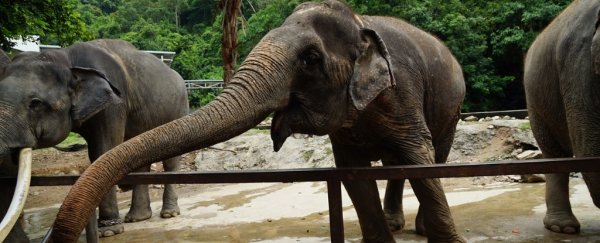Captive elephants are not as healthy as their native counterparts. Under the care of zookeepers, these large terrestrial mammals have shorter life spans and far lower birth rates.
Obesity from under-excising or over-eating is often thought to be the cause, and yet new research suggests Asian elephants (Elephas maximus) in captivity are just as active as what has previously been observed in their wild counterparts.
Comparatively speaking, captive Asian elephants have less fat on them than the average human, and probably walk more as well.
Whether or not these captive elephants are fatter than wild ones is still under debate. In the past, studies have classified nearly three-quarters of all elephants in North American zoos as overweight or obese, but these scores are usually based on visual observations only, which can be deceiving.
While elephants under human care can weigh more, it's unclear how much of that extra weight is fat and how much of it is from overeating or under exercising. What's more, it's not clear what effect that fat has on their health outcomes.
Daniella Chusyd, who now studies elephant physiology at Indiana University Bloomington, wanted to measure the fat content of elephants in a more direct way. Whilst at the University of Alabama, she decided to compare the amount of fat on captive elephants with some of their health issues.
"I was interested in discovering whether methods predominantly used in human health research could help us learn more about elephants," Chusyd explained.
To that end, Chusyd and her colleagues equipped 35 female Asian elephants and 9 male Asian elephants from nine zoos across the US and Canada with jumbo-sized fitness trackers on their ankles.
Chusyd then "quickly became their best friend" as she fed the elephants a dose of bread soaked in heavy water - it contains a naturally occurring isotope of hydrogen that would help the team to measure the elephants' water weight.
Tracking their water weight through regular blood samples, she and her colleagues were ultimately able to calculate the elephants' total fat levels from their overall body mass.
In recent years, some scientists have grown concerned captive elephants are eating too much and not exercising enough, potentially putting them at risk of cardiovascular disease, joint problems, and abnormalities in their reproductive hormones, which could undermine the future of this endangered species.
Some of those fears, however, might be misplaced. While captive elephants are clearly not as healthy as they would be in the wild, their fertility issues may not arise from a lack of exercise or added fat.
On average, male elephants were found to carry roughly 8.5 percent body fat and females roughly 10 percent. To put that in a mammalian perspective, a healthy human carries between 6 and 31 percent body fat.
Comparing these fat contents to other health issues in Asian elephants, the authors found the exact opposite of what they were expecting.
Fitness-wise, the elephants in captivity were walking just as much as they would if they had free range, roughly 0.03 to 2.8 kilometres each hour.
Fertility-wise, it was actually the underweight elephants that appeared to be struggling the most - not those with extra fat. Infertile females carried the least fat of the lot, and the authors think this loss of weight might be disrupting their fertility cycles, rather like what happens in underweight humans.
This isn't to say there aren't risks for elephants that are overweight, just that a low birth rate may not be one of them.
In the study, for example, researchers found insulin levels were greatest among elephants with higher-than-average body fat, which suggests these large mammals could very well develop a diabetic-like state if they eat too much, although this has yet to be verified.
It's still not clear if Asian elephants in zoos are experiencing obesity at a higher rate than in the wild. After all, obesity is extremely difficult to define, even in humans.
More research needs to be done to determine what level of fat is unhealthy in Asian elephants, and where the fat is distributed, whether it be subcutaneous or visceral.
What this study does suggest is that many Asian elephants in captivity are receiving ample exercise. What's more, a higher fat content is not necessarily tied to an elephant's reproductive cycle, although it might impact other parts of their health.
"Although an attempt was made to establish an adiposity threshold, it must be emphasised that this is a new technique in elephants, the study involved a relatively small sample size, and there were no data on adiposity and mortality, so future work with larger sample sizes and greater ranges in body condition are needed," the authors conclude.
Finding a way to keep elephants healthy and fertile in captivity will be crucial for the future of this endangered species.
The study was published in the Journal of Experimental Biology.
